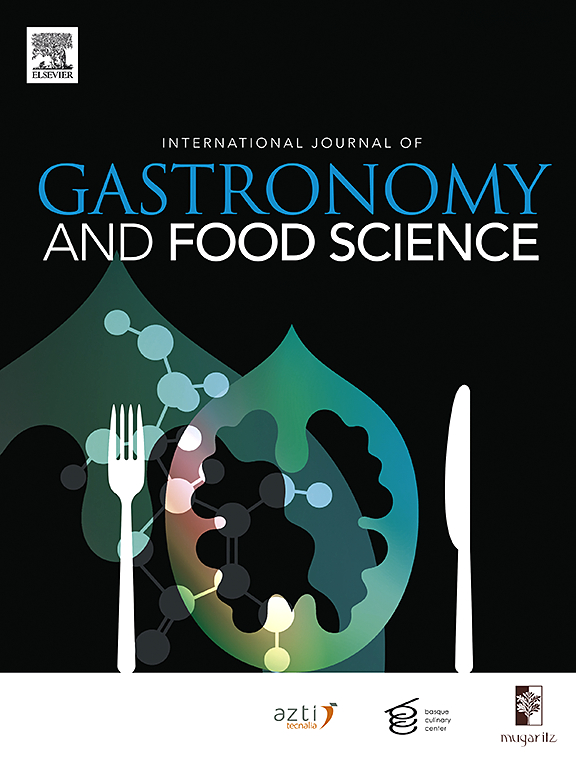非常规冻干水果通过分子烹饪和微胶囊技术来保持其品质属性
IF 3.6
2区 农林科学
Q2 FOOD SCIENCE & TECHNOLOGY
International Journal of Gastronomy and Food Science
Pub Date : 2025-07-01
DOI:10.1016/j.ijgfs.2025.101235
引用次数: 0
摘要
将微胶囊化技术与分子烹饪技术相结合,开发了新型可再水化水果。草莓用辣椒油树脂浸渍,黑莓和芒果用辣椒或橙皮油微胶囊浸渍。所有的水果都被冷冻干燥,然后再水化。评估了颗粒大小、颜色、质地、再水合能力、水分含量和维生素C水平。对水合水果进行了感官评价。将辣椒油树脂微胶囊(0.114 μm)浸渍在草莓中,失水0.666 g/g,固相增加0.0163 g/g,复水能力(RC)为69.612%。对于直径1.5 cm的芒果椒和黑柿桔大球,RC值分别为37.363%和35.349%。结构分析表明,巨球表现得像软糖。保存了维生素C (Tukey, p <;0.05),颜色参数变化显著(Tukey, p <;0.05)。120名小组成员的感官评估得出的总体可接受性得分为7.26,Pearson相关检验显示,颜色是对该值影响最大的属性(R值0.864-0.823)。这项研究表明,通过将分子烹饪、微胶囊化和科学方法与当地烹饪和原材料相结合,烹饪文化可以创新。本文章由计算机程序翻译,如有差异,请以英文原文为准。

Non-conventional freeze-dried fruits preserve their quality attributes through molecular gastronomy and microencapsulation techniques
Novel rehydratable fruits were developed by combining microencapsulation and molecular gastronomy. Strawberries were impregnated with pepper oleoresin, while black sapote and mango macrospheres were enriched with pepper or orange peel oil microcapsules. All fruits were freeze-dried and subsequently rehydrated. Particle size, color, texture, rehydration capacity, moisture content, and vitamin C levels were evaluated. A sensory evaluation was carried out on rehydrated fruits. Pepper oleoresin microcapsules (0.114 μm) were effectively incorporated into strawberry through impregnation, achieving a water loss of 0.666 g/g and a solids gain of 0.0163 g/g, and their rehydration capacity (RC) was 69.612 %. For macrospheres (1.5 cm diameter) made of mango-pepper and black-sapote orange, RC values were 37.363 % and 35.349 %, respectively. Texture profile analysis showed that macrospheres behaved like gummy candy. Vitamin C was preserved (Tukey, p < 0.05) in all the fruits, while color parameters significantly changed (Tukey, p < 0.05) in both macrospheres. Sensory evaluation with 120 panelists yielded an overall acceptability score of 7.26, with color being the attribute that has the most influence on this value, as showed by a Pearson's correlation test (R values 0.864–0.823). This study suggests that culinary culture can be innovative by merging molecular gastronomy, microencapsulation, and scientific approaches with local cuisines and raw materials.
求助全文
通过发布文献求助,成功后即可免费获取论文全文。
去求助
来源期刊

International Journal of Gastronomy and Food Science
Social Sciences-Cultural Studies
CiteScore
5.30
自引率
10.50%
发文量
170
审稿时长
45 days
期刊介绍:
International Journal of Gastronomy and Food Science is a peer-reviewed journal that explicitly focuses on the interface of food science and gastronomy. Articles focusing only on food science will not be considered. This journal equally encourages both scientists and chefs to publish original scientific papers, review articles and original culinary works. We seek articles with clear evidence of this interaction. From a scientific perspective, this publication aims to become the home for research from the whole community of food science and gastronomy.
IJGFS explores all aspects related to the growing field of the interaction of gastronomy and food science, in areas such as food chemistry, food technology and culinary techniques, food microbiology, genetics, sensory science, neuroscience, psychology, culinary concepts, culinary trends, and gastronomic experience (all the elements that contribute to the appreciation and enjoyment of the meal. Also relevant is research on science-based educational programs in gastronomy, anthropology, gastronomic history and food sociology. All these areas of knowledge are crucial to gastronomy, as they contribute to a better understanding of this broad term and its practical implications for science and society.
 求助内容:
求助内容: 应助结果提醒方式:
应助结果提醒方式:


